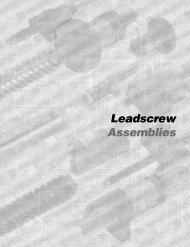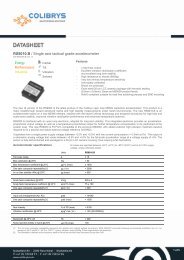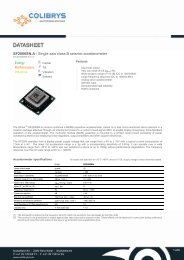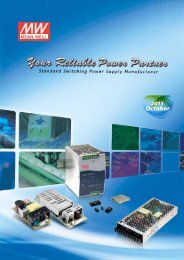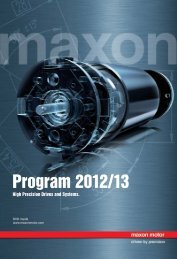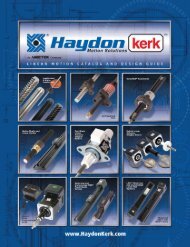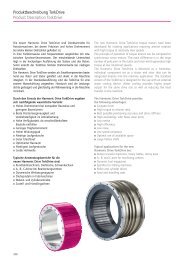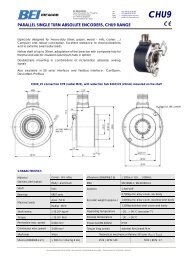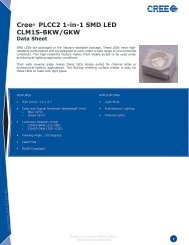Stepper drives Servostep drives Controllers 2012
Stepper drives Servostep drives Controllers 2012
Stepper drives Servostep drives Controllers 2012
Create successful ePaper yourself
Turn your PDF publications into a flip-book with our unique Google optimized e-Paper software.
f 4 d 2 technology for optimized motor control<br />
in open and closed loop<br />
PRODUCTS<br />
The f 4 d 2 technology (Fast Forward Feed Full Digital Drive) obtains, thanks to<br />
the sinusoidal regulation free of parasitic harmonics and a high chopper frequency<br />
of the phase current, a silent motor rotation from the drive without<br />
resonances, a maximum torque at every speed and high efficiency.<br />
With the servo step <strong>drives</strong> developed for servo performances, Ever Elettronica<br />
have extended the motor control from the traditional micro-step control in<br />
open loop to stepless control with synchronous sinusoidal excitation of the motor<br />
phases, unlike the micro-step control that doesn’t exclude step synchronism<br />
loss, even in presence of fast motor accelerations. The servostep system is realized<br />
with a motor feedback system with an incremental encoder with a resolution<br />
depending on the dynamic accuracy required by the application.<br />
Normally it’s also possible to obtain performances equivalent to brushless systems<br />
performances with inexpensive low-resolution encoders (400 ppr), which can simulate the functioning of a stepper<br />
motor only in combination with a high resolution encoder. In the servostep systems the encoder feedback doesn’t simply<br />
exist of recognizing the occurring step loss during or at the end of the motor movement, but guarantees the continuous rotor<br />
movement synchronism. The stepless phase excitation, characterizing the servostep systems with an optimized excitation<br />
angle to reach a higher velocity and step resolution than when using the micro-step technology, avoids resonances due to<br />
the motor structure and rotor oscillations near the final position.<br />
Moreover, it maximizes the torque generated by the motor to vary the speed and reaction capacity instantly to load changes<br />
obtaining excellent dynamic performances even in presence of almost purely inertial loads and without the need for mechanical<br />
resonance researches (FFT) and module and phase analysis executed for the brushless <strong>drives</strong>.<br />
Open loop and closed loop<br />
TEMPO IN MICROSECONDI TEMPO IN MICROSECONDI TEMPO IN MICROSECONDI<br />
Coppia<br />
Anello Chiuso<br />
f 4 2<br />
d<br />
Velocità<br />
The servostep <strong>drives</strong> avoid the oversizing occurring in open loop<br />
stepper systems to ensure the correct functioning in all load<br />
situations. They are capable to quickly reach and stabilize<br />
the desired positioning reference tracking value in movements<br />
with a direct coupling to the load until a speed<br />
of 2000 rpm, replacing <strong>drives</strong> with a brushless motor<br />
to diminish costs in applications of which the<br />
resonance frequency varies depending on the load<br />
variation applied to the motor, which makes application<br />
parameterization through automated<br />
learning systems impossible.<br />
All feedback management adjustments to the<br />
programmable <strong>drives</strong> in open loop and servostep<br />
are made by means of RS232 or RS485 serial interfaces<br />
or by CANbus or profibus fieldbus connection,<br />
depending on the used drive version.<br />
Through these interfaces it’s possible to configure<br />
the control parameters of the drive and feedback<br />
loop by means of special software, to execute the application<br />
settings with real time scope monitor and to<br />
manage by means of IDE the programming and debugging<br />
of user applications managed by the firmware of which<br />
the Ever Elettronica <strong>drives</strong> are equipped additionally to the motor<br />
control functions in open and closed loop.<br />
Posizione<br />
3



